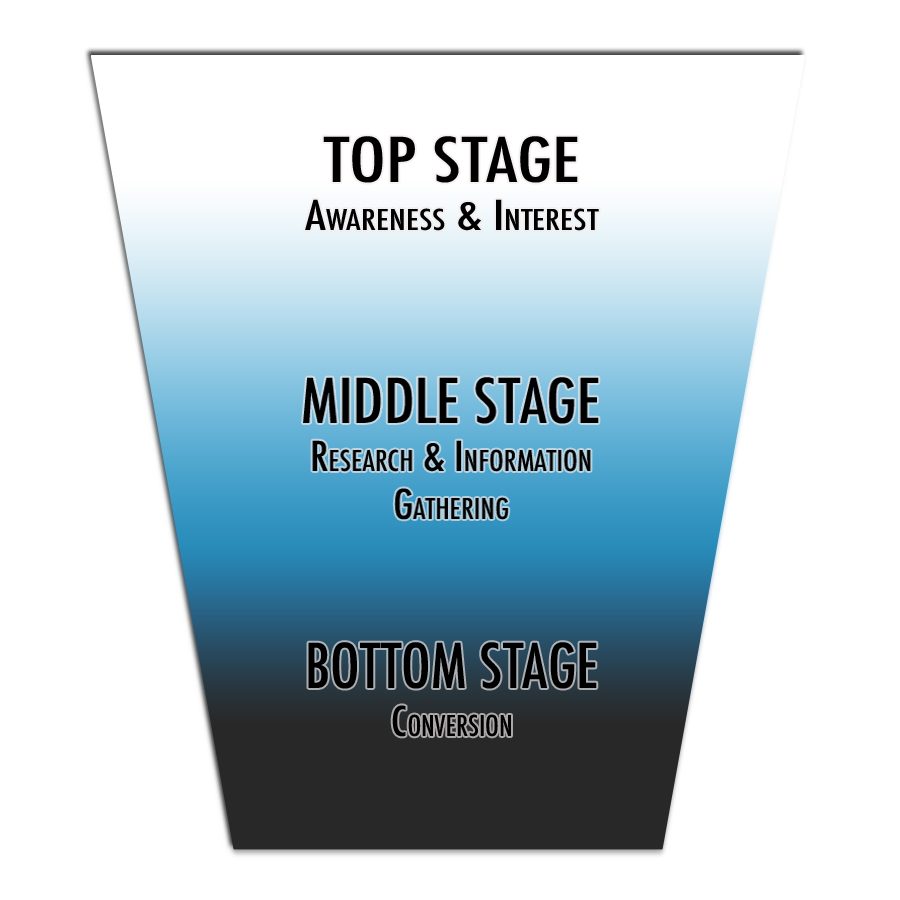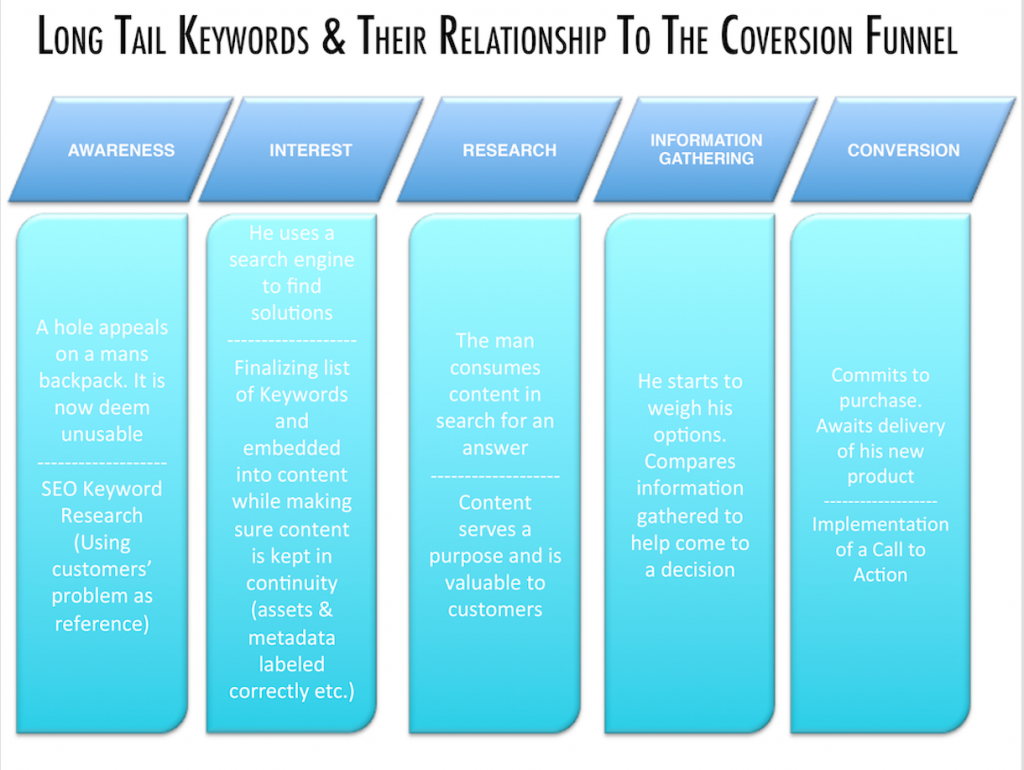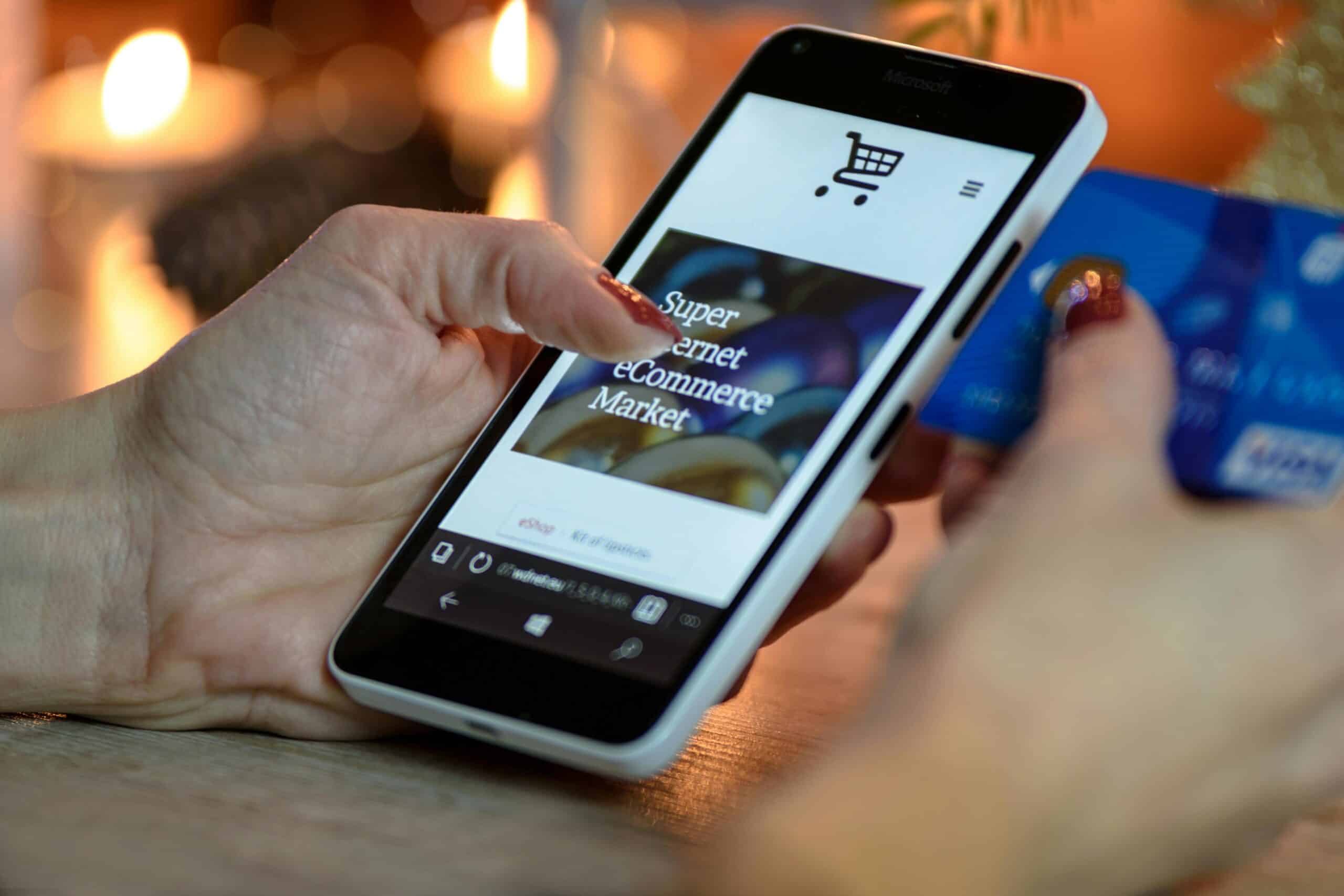
We often make the mistake of assuming the buying process for customers is simple. They find out they are in need of a product or service, then they come to a decision on whether or not to make a purchase. While it safe to say that’s an oversimplification of the entire process, in actuality the process involves many stages. All of which have some degree of influence to the customer on their buyer decision. It is well known that long tail keywords are higher converting for the pure fact that the user is far more researched and decision orientated than someone searching a more general search. So given this, below is how long tail keywords fit into the conversion funnel from both a SEO and conversion orientation.
For this to make sense I need you to imagine yourself as a potential customer. The actual buying process is often described as a funnel with each stage dealing with a specific issue. At any point during this process, a customer may become disinterested/distracted and opt out of the decision-making process. This is often described as ‘dropping off’. So by placing yourself in the shoes of your customers one can render a much better understanding of the behaviours involved in each stage. We can then find out which areas our customers are falling off the funnel and take critical steps to rectify those users who are dropping out of the conversion funnel; be it those searching in a general keyword search or a more specific long tail keyword search.
TOP STAGE (AWARENESS & INTEREST) – LONG TAIL KEYWORD RESEARCH
Any potential customer starts at the AWARENESS and INTEREST stage. As you would imagine this stage involves the point where the customer starts to become aware of their situation. Whether they realise it or not they’ve come across a situation where they need or want something. This poses a ‘problem’ for the customer since they haven’t fully understood the situation or the need. To put things into perspective, a certain problem or situation has occurred (AWARENESS) and now they’ve begun seeking an answer or solution (INTEREST). Let’s use an example of a man trying to find a backpack for work throughout this article.
People within the SEO industry try to meet their customers halfway by understanding the nature of their problem. Take our example, the man looking for a backpack. He goes to his favored search engine (most likely Google). He types ‘work backpack’. After he’s had a look around he decides that nothing compelling pops up, so he modifies his search. In goes ‘laptop work backpack’. Still not being satisfied with his search options, he goes another step above and refines his search, looking for ‘Macbook Laptop Backpack’. By understanding the nature of the problem (the search) we can make strategic assumptions on the type of keywords (the solution). We can then compare our strategic assumptions with keywords known for higher search traffic and higher conversion but are also relevant to our proposed solution and optimise from here. It’s important to note that they are in fact strategic assumptions as we have no data to correlate whether the keywords have been effective and conversion prone. This comes later. However, we embedded those keywords into our content and optimise our online assets accordingly. This process allows our content to rank higher due to our increased relevancy to these longer tail keywords.
Targeting specific and more refined search terms is commonly known as searching via long tail keywords. What’s important to remember here is that users who typically search via long tail keywords are more inclined to convert. SearchEngineWatch summarised a recent study that discovered that long tail keywords had an effectiveness in conversion rate of 2.5 times over their counterpart, head keywords (often broader keyword search, but with a greater demand on search engines). Once we begin using keywords for our search, we eventually evolve our initial idea into something more specific and refined to better our search results. But in order to determine which keywords have higher search volume in search engines, we suggest taking a look at Google’s Keyword Planner. Then cast your eyes over to ‘Keyword Ideas’ section for some suggestions on some longer tail keywords and you’ll soon discover what a fantastic online resource this is. Combining this useful tool along with having an understanding of the customer’s problem we can start to generate a few keyword combinations that will work effectively with our proposed content. Other than that it can still provide a general sense of keyword strategy direction and allow us to swap in and swap out keywords that are underperforming from a conversion standpoint.
CASE STUDY #001 – Linen House – Fabric and Bed Linen
In the past, we’ve worked alongside a company in the business of offering fabric and linen to the general public (B2C). They were interested in their own search rankings and wanted to aim higher so sought our services. We took a look at their business and understood what they excelled in and what keywords their potential customers could possibly search for. With that under consideration, we were able to narrow our keyword list to ‘Bed Linen Sale’ and ‘Doona Cover Online’ and from this we were able to successfully integrate those keywords into their content and more importantly their content strategy. Within a few months, Business A ranked number 1 in those specific keywords. By merging the ideas of a business’ core competencies as well as the understanding the potential customer’s keyword searches we can make strategic assumptions onto a set list of keywords that will work most effectively with their content.
**
The key takeaway here is to make sure that when choosing keywords that we look to incorporate keywords not only into meta optimisation but also into a well thought out content strategy too. Make your optimisation an ongoing pursuit not just a once off audit type model.
MIDDLE STAGE (RESEARCH & INFORMATION GATHERING) – CONTENT THAT PROVIDES VALUE
The middle stage is where the bulk of the RESEARCH occurs for the customer. The customer has a general sense of a potential solution but at the same time, they need more information to firmly make any decision. They’ve decided on a few keywords that may help with their problem and have ultimately been brought to multiple pages/websites with many different options. Their goal now is to narrow the possible options by RESEARCH and GATHERING INFORMATION that is necessary to making a purchase decision.
Remember how we told you to do some keyword research in the first stage. Well now would be a good time to start thinking where those specific keywords would be most suitable within your content. There are plenty of other considerations for SEO to be done at this point. Consistent metadata (description, title, keywords, robot.txt, h1’s, h2’s, images and all assets), making sure headings and image titles are labeled in an appropriate manner as well as considerations to site navigation. All these small improvements help with the quality of relevancy to search terms, allowing better search rankings due to the consistency and quality of the platform. But for today we’re going to fixate on the value of our seo content and what that can offer to potential customers.
Since content is now of utmost importance we need to carefully consider how content is presented to potential customers. Let’s jump back to the man looking for a backpack for a second. He’s stumbled across a brand that seems intriguing. However he’s overwhelmed by the choices presented, so he begins to narrow his scope by looking at specific information that holds some significance. He may be considering the size of the bag and start looking into dimensions and descriptions written. Or maybe he’s started comparing the product line to see which provides any additional outstanding benefits. All these relevant pieces of information are in one way or another influencing his purchase decision. So it’s our duty to produce content that can appear valuable to potential customers.
Our suggestion for having content that’s valuable to the customer is taking a look at your own unique selling proposition. Figure out what forms of content best supports or showcases your strengths and take it from there. In the meantime here’re some general suggestions that most businesses can apply to their content.
- PRODUCT COMPARISON TOOL – Allowing potential customers to compare specifications and prices provide a convenient method for weighing options. It’s always appreciated by customers who are overwhelmed with their choices of available products.
- COMPLIMENTARY MEDIA (IMAGES & VIDEOS) – This one is a given. But there should always be some form of complimentary pieces of content that can easily demonstrate the product or service. Even one step better is to show the product in action allowing the customer to perceive the benefits of the product or service. Also, note to improve consistency with your keyword SEO strategy, make sure all your titles of your media are in line and consistent.
- REVIEWS – a dedicated section for reviews can be viewed as a good and bad feature. On one hand, you’ll love the fact people are leaving positive reviews, while you’ll shy away from those leaving negative reviews. Whatever your opinions are on the matter, reviews help build an understanding of how the product was used and demonstrating different scenarios. In most cases the reviews help potential customers relate to their own situations, ultimately helping with their decisions. It is also a positive that user generated content is being applied to your site as it keeps the site fresh with new content.
- DELIVERY/ETA/PICKUP INFORMATION– this primarily relates to the goods sector. But if you happen to include any information on delivery or transportation is always appreciated by those that need to plan ahead. Imagine if a customer is in immediate need of a product. Having the delivery information on hand can help with the immediacy of their situation. While that’s an exaggerated example you can understand that time can also be a consideration when making a purchase.
- FAQ SECTION– it’s safe to assume that the past and future customers will have some queries with regards to your offerings. Creating a collection or forum that allows questions to be asked and answers allows potential customers to seek if any of their concerns were noticed or even answered.
- RATING SYSTEM – similar to our suggestion with reviews, having a rating system allows potential customers come to a decision by the scale of quality in place. While it should go hand in hand with the review section, having a simple and accessible scale allows potential customers to quickly gauge the product at a glance.
Take a quick look at our case study on how we achieve similar success.
CASE STUDY #002 – Are You Selling
Many of the sites we get approached to work on are static in nature. Website/business owners fall into the trap of the typical static business card website, which has very little fresh content, if any. These sites are simply not going to rank now and or ever unless they incorporate a keyword strategy within a dynamic framework. Are You Selling is a great example of a once static site turned into a dynamic content powerhouse. We developed and integrated the ability for Are You Selling to list every car they sold and the price at which it was sold for. We delineated and categorised by make, model and geolocation. What does this achieve? It achieves two very important things. 1. It shows users and Google that this business is active. 2. It provides a strategic optimisation framework for Are You Selling to operate within comfortably and thus generate targeted content for the benefit of the site > users & Google. In this case we have aligned with first recommendation ‘Product Comparison Tool’. By providing users with sell price, make and model we are enabling the user to price compare and find a yardstick. As a result ‘Are You Selling’ are seen as credible and a relevant source for pricing of cars which is ultimately what they execute on a daily basis as a business. In this case we have also aligned with the second recommendation ‘complimentary media’ by uploading images of each car that is sold we are complementing and verifying the data which we are perpetuating to the market through our client’s site.
BOTTOM STAGE (CONVERSION – END) – ENDING ON A STRONG NOTE
The last stage is focused on the event that the potential customer wants to convert into an actual customer. The previous stages within the funnel all act as a prelude to this final but crucial stage. It’s important to note that the customer has already made their decision on the purchase. All that’s needed is a little nudge in the right direction to fully commit to their decision.
What’s effective for making the conversion happen is a technique called ‘Call to Action’ (C2A). The main point for a C2A is to invoke a response from potential customers into making a purchase. For the last time let’s go back to the man looking for his perfect backpack. After careful deliberations and consideration, he’s arrived at his final pick. It fulfills all his desires and needs for a backpack. He’s about to commit on his decision and proceeds to make the purchase. He inputs all payment and delivery details and he’s finished. He’s come to the end of the funnel. All that’s left is the arrival of his brand spanking new backpack. He’s come a long way to this point where he commits to a purchasing decision and actually proceeds forward.
There are many considerations that need to be fully understood to create a compelling C2A that effectively works. We’ve taken a look at a few C2A’s around the web and have noticed a few similarities and common elements shared between the truly successful C2A’s. Here’s some thoughts on what measures are needed for an effective C2A.
- EMOTION – is often regarded as a considerable influencer. Its main purpose is to appeal to a certain emotional state that the customer can easily empathise with. Let’s take the sense of belonging as an example. Writing copy that infers a sense of ‘familiarity’ or ‘comradery’ all appeal to wanting to be welcomed and accepted by others.
- TIME/SEASONALITY – the mention of a countdown or limited time issues a sense of urgency. The customer will assume they need to act immediately otherwise they can lose out on a sale or a limited offering.
- SHORTAGE/SCARCITY/LIMITED – similar to Time, its appeals to the urgency of the situation where the customer may miss out on an opportunity due to lack of availability. If there’s a mention of ‘Limited availability’ or ‘Only 50 opportunities left’ they often imply that the special offering is only those who can act in a timely fashion.
- IDENTIFIABLE and ACCESSIBLE – above all else, your C2A needs to be clear and understood by potential customers. If the potential customer commits to making a purchase of sorts, your C2A is what most customers would be looking for to guide them to purchase. Having the C2A identifiable and clear to the customer so they understand where to go when proceeding forward is a surefire way to increasing your conversion rate.
When you’ve nailed your C2A down, start to think of any other avenues that can help transition potential customers in actual customers. For an idea take a look at our mini case study below.
CASE STUDY #003 – Linen House – Fabric and Bed Linen
Linen House run periodic sales to boost revenue much like many other ecommerce platforms. This sale calendar is incredibly important and must be adhered to to maximise revenue through the retail season. Christmas sales are an important time for retail. So we introduced strategic remarketing ads to increase conversion. How does remarketing help increase conversion? We set up lists of users that had visited certain types of products on Linen House’s site. For instance we had a list of all those that had visited the sheets category of the site. We then used this smart data to advertise to them during their Christmas shopping period. This dramatically increased conversion because we were simply placing products the user was already interested in into ads and reminded them of their interest during a sale period. Because it was during a sale period it was discounted from the price they had seen previous. This aligns with both recommendation two ‘Time/Seasonality’ and ‘Shortage, Scarcity’.

Phew, that was quite a ride. Let’s do a quick recap. The conversion funnel is a process that all customers go through when dealing with making a buying decision. It’s unavoidable. To make things simpler we’ve narrowed what is normally a multistage process into 3 simple stages. The first stage deals with acknowledging a problem has occurred and something needs to be done in order to resolve the issue. So we try to meet the customer halfway and research into keywords that he or her will likely search for. But to narrow our approach we target those long tail keywords that are inherently more refined and specific. The next stage is where the customer seeks out information on possible solutions that can help fix their problem. Those keyword researched should now already be embedded throughout our own content in hopes potential customers searches leads to our brand. At this point we need to be sure that our content is well optimised (assets labelled correct, meta tags are consistent etc.) and that our content ultimately proves useful for potential customers. When the customer has gathered enough information through research they ultimately come to a decision. They’ve either decided to commit to a purchase or not. We hope for the former. Sometimes they may need a little nudge in the right direction and that’s where a strong Call to Action comes into play in hopes to drive the purchase decision home. We as marketers have to know this process as thoroughly as possible. Each stages provides a unique opportunity for a potential customer on becoming an actual customer. Only by refining and improving our conversion funnel we can hope that potential customers stay on the right path and continue to make a purchase.
Did you enjoy today’s article? If you did, check out SEO Company Melbourne – the home of insightful and actionable SEO-related content, as well as excellent SEO services to help your business!


